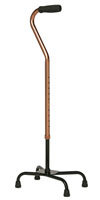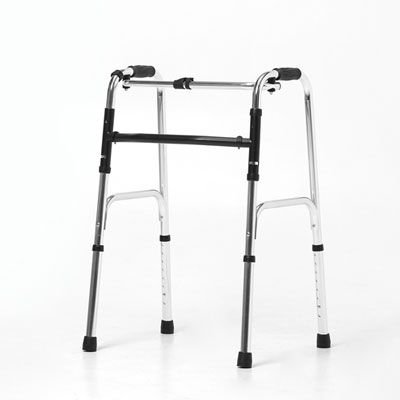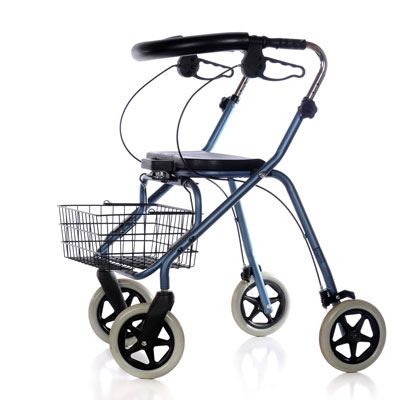Best Walking Aids for the Elderly

Why Invest in a Walking Aid?
A walking aid can bring added freedom to your life, allowing you to move freely, unassisted, with added confidence. They aid in balance and can help you move more easily from place to place. Some that provide more weight-bearing support can also keep you on your feet longer if you experience discomfort when standing for long periods of time. If you experience light to moderate mobility challenges, a walking aid can be a great alternative to wheelchair or scooter.
The advantage of walking aids over such devices is that they allow you to engage in more physical activity for improved health and wellness. They are also, in most cases, much easier to transport, helping you to participate in the activities you enjoy most. To decide what mobility option is best for you and your lifestyle, consult with your doctor about your mobility challenges and activity level.
Types of Walking Aids
There are four three types of walking aids, each with its own subcategories. They offer varying amounts of support and range greatly in size maneuverability. The type of walking aid you select will depend on your preferences and specific needs.
Canes

There are two primary types of canes, standard and quad-canes. Standard canes are highly transportable, and come in a variety of style options. They are used primarily to support stability and balance, and are not ideal for bearing weight (as a walker might be). These canes come in two standard handle types, “C canes” with a smooth curve, and “functional grip” canes, which features a straight handle for added balance. A quad cane splits at the bottom, providing 4 points of contact with the ground for added stability. Forearm canes are also quite popular, distributing weight off of the wrist.

Though less common, some seniors appreciate a cane which also features a seat, which provides a break for those who have trouble standing for long periods of time. These canes fold out to become a small portable seat as needed. Another type of walking cane that puts an emphasis on convenience is the folding cane, which is great for compact storage, and to pack when traveling.
Features to Consider:
- Handle type
- Grip type
- Weight/Durability
- Foldable design
- Points of contact
Our Favorite Models:
- This Quad Cane from Vive
- This beautiful C-Cane for ladies
- Travelon’s Seated Cane
- Drive Medical’s Heavy Duty Folding Cane
Walkers
Walkers come in two types: with wheels and without them. Each provides increased stability, compared with a cane, and those with wheels are easier to move. A walker without wheels, often called a rigid walker, is more stable if you have trouble balancing, but can be more difficult to use for long periods of time, as it must be lifted for each step.
If you tire easily or suffer from weakness or pain in your hands or arms, a rolling walker may be easier to use. Because these have wheels on the front, you must only slightly lift the back to legs of the walker to move forward. Because the back legs act as a break, these can often be easier to get used to than a rollator with a hand break.
If you have limited use of one of your hands, you might consider a hemi-walker, designed to support those with weakness on one side. They function much like a cane, supporting you from one side.

Features to Consider:
- Wheels
- Grip
- Weight/durability
- Packing ease
Our Favorite Models:
- This top-selling Wheeled Walker from DMI
- This well-priced Wheeled Walker from Invacare
- Drive Medical’s One Side Hemi-Walker
Rollators
Rollators function much like a walker with wheels, but with added benefits like hand breaks, and a seat for convenience. These are a very popular option because they offer great mobility assistance, with features that help you maintain your independence, and keep going longer.
Most rollators have a 4-wheel design, but some only have 3. 3-wheeled designs offer increased maneuverability, but typically don’t have a seat. 4-wheeled models move less smoothly around tight corners, but provide more support. Heavy duty models typically have 4 wheels and have a higher weight capacity.
The size of the wheel impacts how and where you can move. If you will be spending much time outside, on uneven terrain, be sure to look for larger wheels, which will move more smoothly.

If you plan to travel with your walker, you may want to consider a collapsible or foldable model that will fit easily into a trunk. Foldable models are also quite convenient for storage if you’d like to keep your walker out of the way.
Features to Consider:
- Wheel size
- Break type
- Locking break
- Seat comfort
- Grip (comfort and stability)
- Basket or pockets (to carry your things)
- Packing ease
Our Favorite Models:
- The Nova 3-Wheeled Model
- The Drive Medical 4-Wheeled Rollator
Purchasing Your Mobility Aid
Dependent upon the type of walking aid you’ve selected, the cost could range from just over $10, to a couple hundred. Most canes will cost somewhere around $20 (more if you want something ornate or hand-carved). Walkers and rollators range based on materials and features from about $50 to $250.
Before making a purchase, you should check whether your insurance or medicare covers some or all of the cost of these items. Often, if your doctor deems it medically necessary, you’ll be at least partially covered. Otherwise, check with your doctors office to see if they have any coupons. Often times, manufacturers will offer discounts to medical offices in hopes of getting the staff to refer clients to their products.
Caring for Your Walking Aid
Even though these types of walking aids are usually much less expensive than a mobility scooter or wheelchair, it’s still important to care for your purchase. Be sure to read all care & cleaning instructions. Following these carefully will help ensure the longevity of your device.
The first step to reduce wear and tear on your new purchase is to make sure you select the right size. A walker, rollator, or cane not made for your body type will not support you as well and may wear out too quickly. Measure yourself before your purchase. Note that if you’ve purchased a lightweight model, it will only support a lower weight capacity. Avoid issues by ensuring you purchase a model that’s designed for your weight class.
Watch for signs of wear and tear, replacing caps, wheels, and grips as necessary. This will help your walking aid last and keep you safe. Replacement parts can be ordered online at a low cost. Just make sure you’re ordering a piece that will fit your current model, and never order from a site without first checking their return policy.
Enjoy the freedom that comes with a walking aid, taking care of your new purchase so that you can enjoy that independence and activity for years to come.


